Nook Tablet or Kindle Fire?
That’s the question that’s already bedeviling consumers and gadget aficionados alike.
In a matter of weeks, it seems, the tablet market has been compressed to just a handful of choices. The iPad 2 still rules the high end ($500 and above), but the “e-reader as tablet” option now looms large in the sub-$250 range, with the $199 Kindle Fire going mano a mano with the $249 Nook Tablet.
The Kindle Fire has just started shipping, and the Nook Tablet will follow as soon as tomorrow (a few days earlier than originally expected).
Last year, Barnes & Noble released the Nook Color at the same $249 price. Back then, a 7-inch color e-reader that could run apps as well as read color books and magazines, and even play movies and music, was a revelation. The Android tablet could even be rooted–to many, it became known as the not-so-secret most-affordable Android tablet around with the best design (other similarly priced and more-generic Android tablets are, by comparison, terrible).
With the Fire on the horizon, Barnes & Noble knew it had to up the ante. Thus, 2011’s Nook Tablet takes the basic Nook Color formula and delivers more storage, a faster dual-core processor, an improved screen–and, notably, a larger selection of apps.
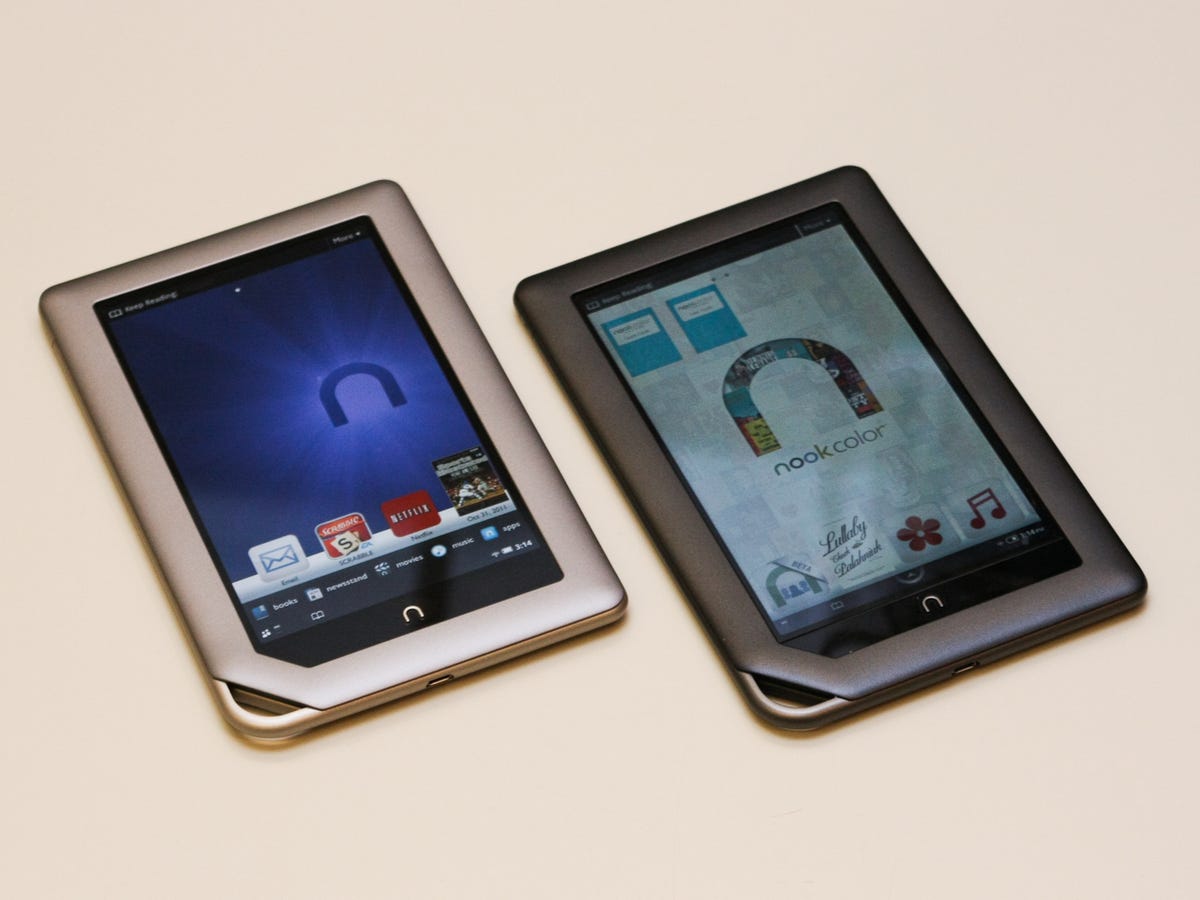
Sarah Tew/CNET
This year’s design is very much like last year’s. The Nook Tablet is to the Nook Color as the iPhone 4S is to the iPhone 4. The Tablet has had a few improvements to its feel and some contours on the tablet–it’s not a carbon copy of the Color, physically–but the carabiner is back, and so is the very appealing minimalist look. The edges and back have a slightly soft touch, not rubberized, but almost like Teflon coating on cookware. It feels nice.
The Nook Color remains as a $199 device, but the Tablet is the color tablet most Nook customers are going to want to buy.
The question, then, is can the Nook Tablet compete with the Kindle Fire–or with the iPad? Barnes & Noble’s latest still feels like a tweener device. The interface and user controls are a bit of an awkward marriage. Pressing the Nook’s version of the Home button brings up a media bar, but various libraries are viewed in different blades. Pressing the Home button doesn’t always bring you back to the home screen; it brings up that media bar on the bottom instead. Tapping the “home” icon takes you home, and…well, you see the confusion. Those familiar with the Nook will feel right at home.
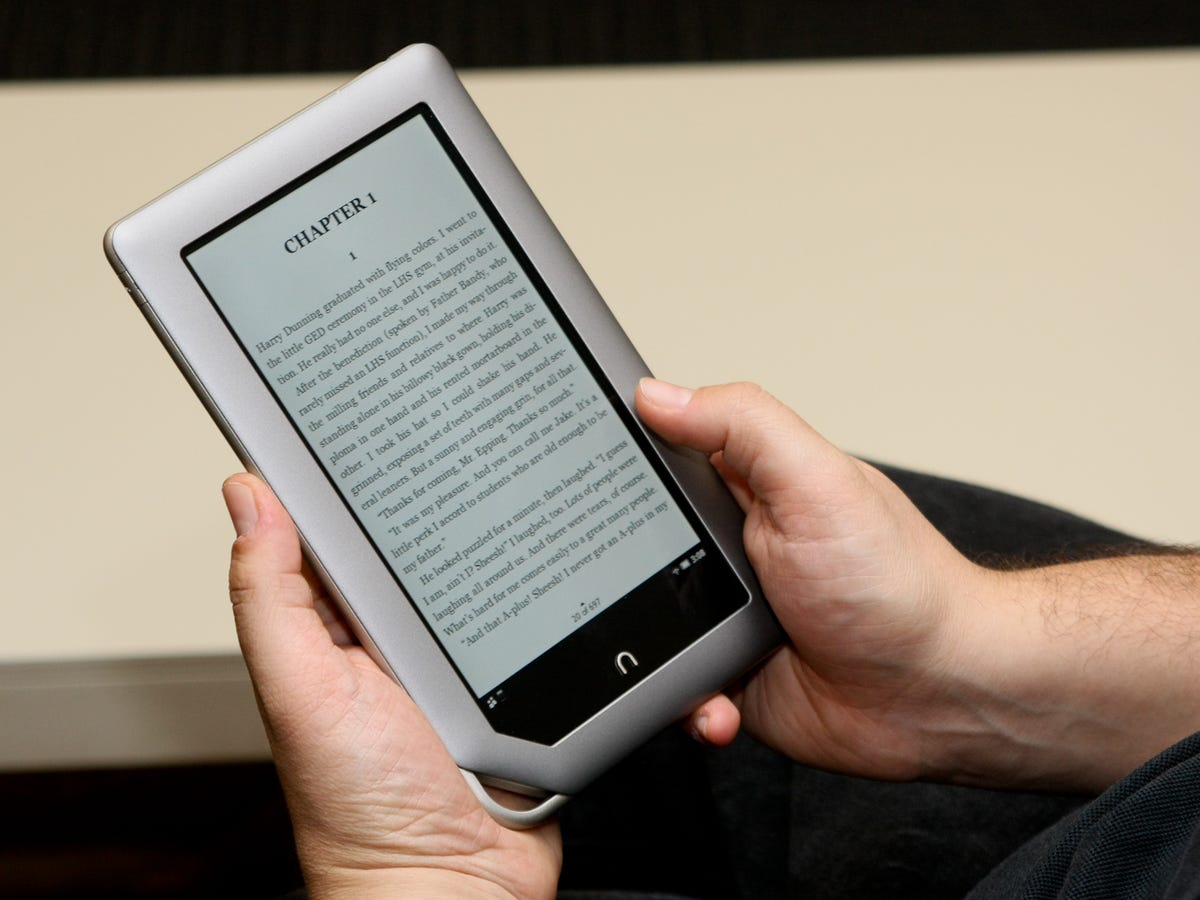

Sarah Tew/CNET
As an e-reader
Let’s put it this way: when shooting the video for the Nook Tablet, I almost forgot to show off the e-reader features. Nook Tablet users could, as absurd as it sounds, make book reading a distant priority, what with all the video, music, gaming, and magazine reading this tablet can handle.
The Nook e-reading software is functional, but not spectacular. Fonts and font sizes–as well as margins and line spacing–can be easily adjusted, offering plenty of flexibility. Still, page turns aren’t silky smooth like they are in Apple’s iBooks app, although they are functionally fast. Book lovers might still prefer an e-ink choice like the Simple Touch over this bright LCD display, but for the extra features the Nook Tablet offers, it’s a worthy compromise. The IPS display is bright and crisp–better than on the original Nook Color–and looks as least as good as an iPad’s display.
Children’s books have been a big part of the Nook’s sales pitch, and they largely don’t disappoint. The handful of books I looked at were colorful and bright, but full pages can get a little small on the screen real estate. Barnes & Noble has proudly shown off the ability to record and save your own voice recordings on these books, and the feature works as advertised. A kid could have page-by-page custom recordings from a grandparent or other relative who isn’t there. It’s similar to what’s available on some iPad apps.
Nearly 200 magazines are offered for issue-by-issue or subscription purchase, with the option for print subscribers to get a free e-version. The layout on these digital versions has been changed to fit the reduced screen space. All the content is the same, but the shrunk-to-fit design might annoy magazine purists.
Comics are also supported via a new store and reader, and a few issues of Marvel comics looked great on the Nook Tablet screen. This is an even better use of a 7-inch screen, and could be the killer app for color e-readers.
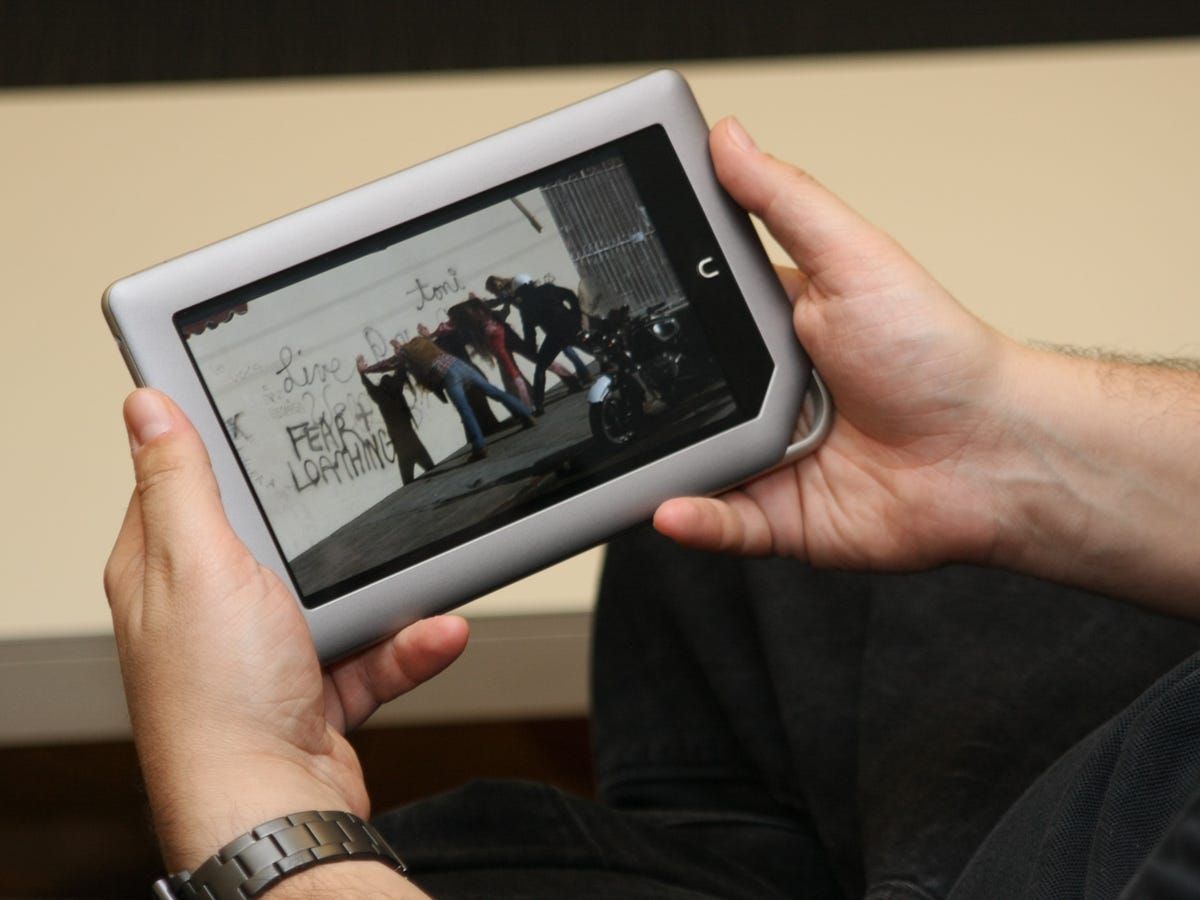

Sarah Tew/CNET
As a video player
Adding Netlfix and Hulu Plus–among others–to the Nook’s color tablet ecosystem is huge. It’s hard not to be impressed by the Nook Tablet’s sharp screen and picture quality. Streaming Netflix and Hulu Plus in the office worked far better than we expected, although there were occasional playback hiccups over our Wi-Fi. We streamed Netflix side by side with the Kindle Fire, and head-to-head comparisons were very favorable to the Nook–it simply looked better. Both tablets have the same app, but the Nook Tablet’s picture looked more vivid and detailed. The Nook Tablet also has physical volume controls on the side, which come in handy–the Kindle Fire strangely lacks them.
However, it’s not enough. The Nook Tablet has no video store like Amazon.com and Apple do, and it’s a big loss for anyone who wants to use this tablet to watch videos away from Wi-Fi–like, for instance, on a plane.


Now playing:
Watch this:
Barnes & Noble Nook Tablet
4:26
That’s not to say you can’t technically store videos. Almost paradoxically, the Nook Tablet has more extra storage space than the Kindle Fire–16GB compared with 8GB–and a microSD card slot on top of that with a capacity up to 32GB. Loading videos or music onto the Nook Tablet would have to be accomplished by sideloading (connecting a USB cable to a PC). The Nook Tablet supports the same video codecs as any Android Gingerbread tablet, so it’s versatile, but it obviously can’t play back videos with DRM protection. That means that those sideloaded video libraries most likely won’t be of the entirely legal variety.
I only bring that up because your mother, father, sister, brother, or grandfather will inevitably ask, “How do I watch my favorite movie on this thing?” The simple answer for a Nook owner is: well, it’s complicated. As much as Barnes & Noble doesn’t want to acknowledge it, the Nook Tablet is a bit of an odd duck for the average person wanting a video-playing tablet.
As a music playerMusic lovers will have no lack of music services on the Nook Tablet. Pandora, TuneIn Radio, MOG, and Rhapsody have apps, among others. And, of course, you could easily sideload your own music via USB. Music is sold naturally DRM-free, and sideloading it isn’t nearly as much of a problem as with video. Yes, the Nook Tablet handles music just fine, but it’s not ergonomically comfortable–and it doesn’t have Bluetooth.
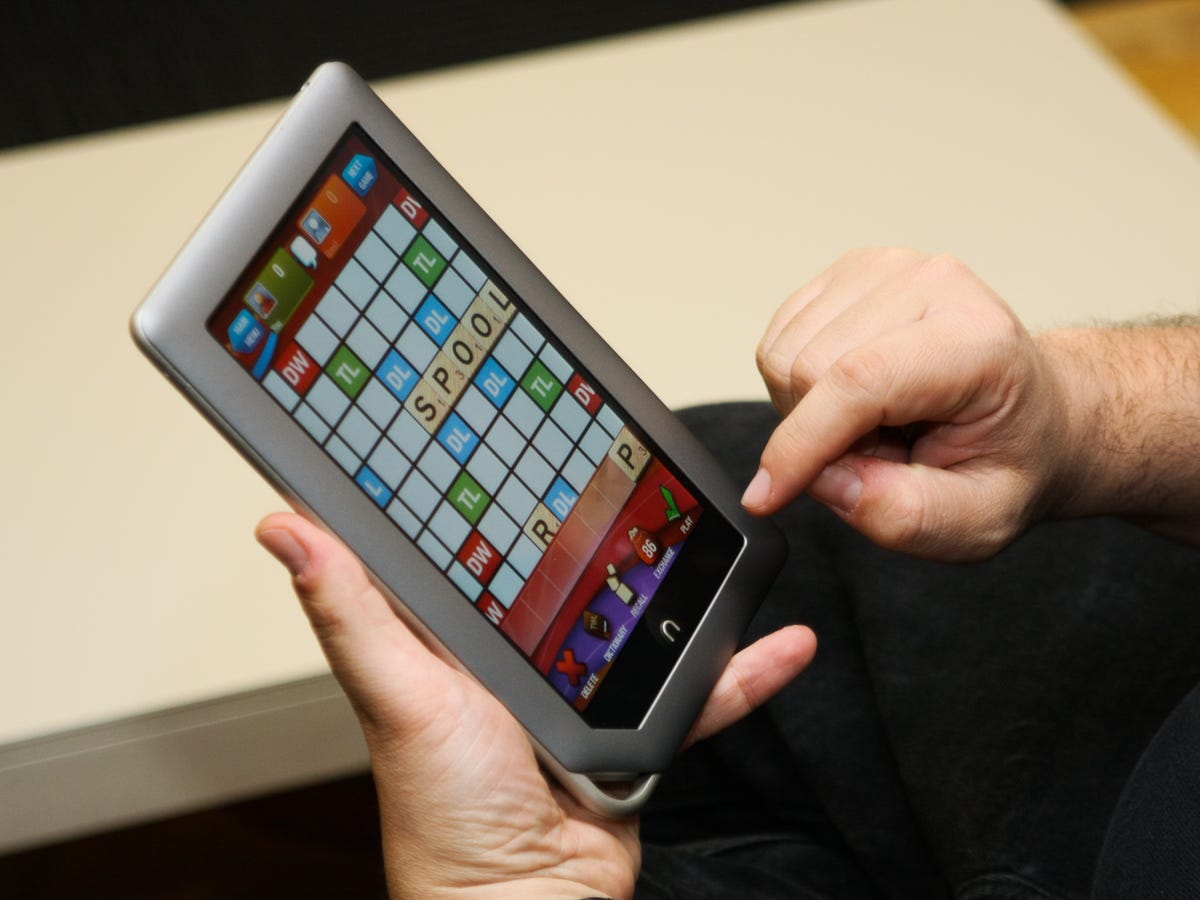

Sarah Tew/CNET
As a gaming device
The Nook Tablet has a decent selection of casual games in the Nook Store, ranging from Angry Birds to Scrabble. They load and play like the average Android app; the screen shows off sharp colors and animations, but the graphics capability doesn’t come anywhere near that of an iPad. Apps load reasonably quickly. Right now the pickings are slim indeed, but for a very casual audience, these games are fine enough. The library would need to grow a lot to consider this a “gaming” device. Apple’s App Store has this beat by at least 20,000.
As a Web browserSurfing the Web on the Nook Tablet is a step up from the Color, but the whole experience still pales compared with browsing on an iPad. Part of the problem is the 7-inch screen: Web pages sometimes load as mobile sites, and Flash support wasn’t always reliable, as is often the case on mobile devices.
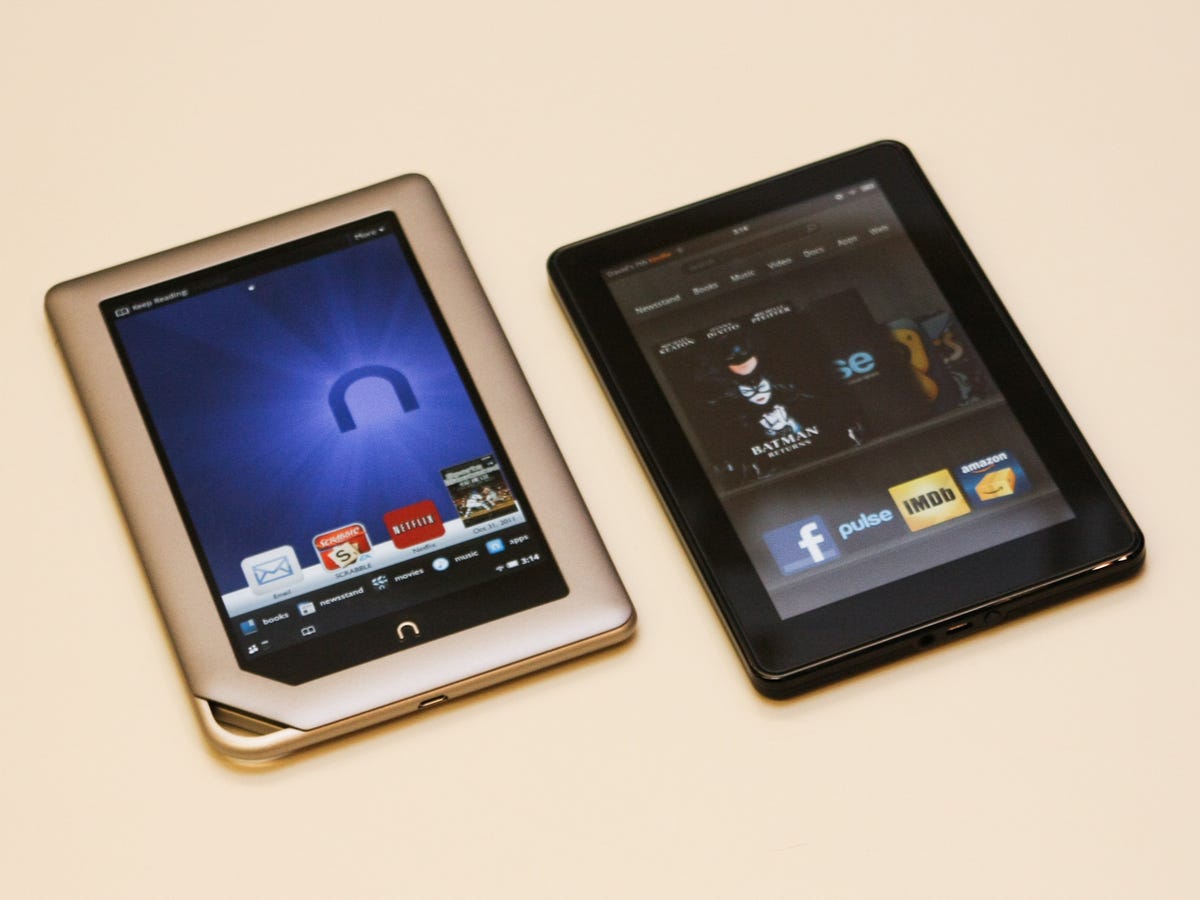

Sarah Tew/CNET
What the Nook Tablet lacks
There are no cameras, no maps, and no Bluetooth, and there’s a general lack of core Android operating system features normally found baked into Android tablets. The Nook is built on Android, but it’s really just an e-reader with apps. It’s impressively versatile, but you’ll have to rely on app downloads from the Nook Store to fill out additional productivity functions.
What’s better than the Kindle Fire
The screen, which is a higher-quality IPS display than the Kindle Fire, really shows off Netflix and Hulu Plus to amazing effect, although we did see the occasional streaming hiccup. It’s the best screen on a budget tablet that I’ve ever seen.
More storage–both onboard (16GB) and via microSD expansion–and the ability to read EPUB files could be big news for those who want flexibility. There’s plenty of expansion room, and you’ll have a hard time running out of space for your apps or your magazine downloads.
What’s worse than the Kindle Fire
There’s a lack of cloud-based media support that Amazon front-loads on the Kindle Fire: no official music or video store, and no way of locally storing downloaded videos outside of connecting the Nook Tablet to your computer. Amazon Prime customers get a bonus pack of borrowable books and free-to-watch TV shows and movies on the Fire. Barnes & Noble has no such subscription service.
The browser isn’t great. Pages were slow to load for us, and often loaded mobile versions of sites instead of the full pages. Flash support, as always on mobile devices, was hit or miss.
Also, yes, it’s subjective, but the admittedly clean-looking Nook Tablet interface is more Android-esque than the eye-popping shelf animations on the Fire. The Nook Tablet might be a superpowered e-reader and media device, but it’s still a budget tablet. Browsing app menus and stores often feels choppy and sluggish. Some might prefer the lack of a Cover Flow-like media flipboard such as the one on the Kindle Fire, but if I’m using this as an e-reader, I’d rather it felt like one as opposed to a mini computer.
Our initial impressions
The landscape of tablets has suddenly changed, and in a considerable, fundamental way. The iPad defined a tablet as a computer alternative; however, thanks to the Kindle Fire and the Nook Tablet, tablets might be equally seen as affordable, incredibly versatile e-readers. The Nook Tablet has an aggressive price and an impressive set of features, and hardware that bests the Fire in several respects. However, it lacks the native music and video stores that Amazon bakes into the Fire, relying on third-party streaming apps instead. Which option is best for you depends on whether you value a video store over greater storage, or, simply, which service you already own more books on, since the Nook won’t display Kindle books and vice versa.
Make no mistake, however: the competition in this entry-level tablet space is aggressive, and it’s quite likely that there may not be a clear-cut winner. This may well be more of a “Pepsi versus Coke” situation, where personal preferences and brand affiliation trump hardware and software considerations.
Check back for our full review tomorrow.




